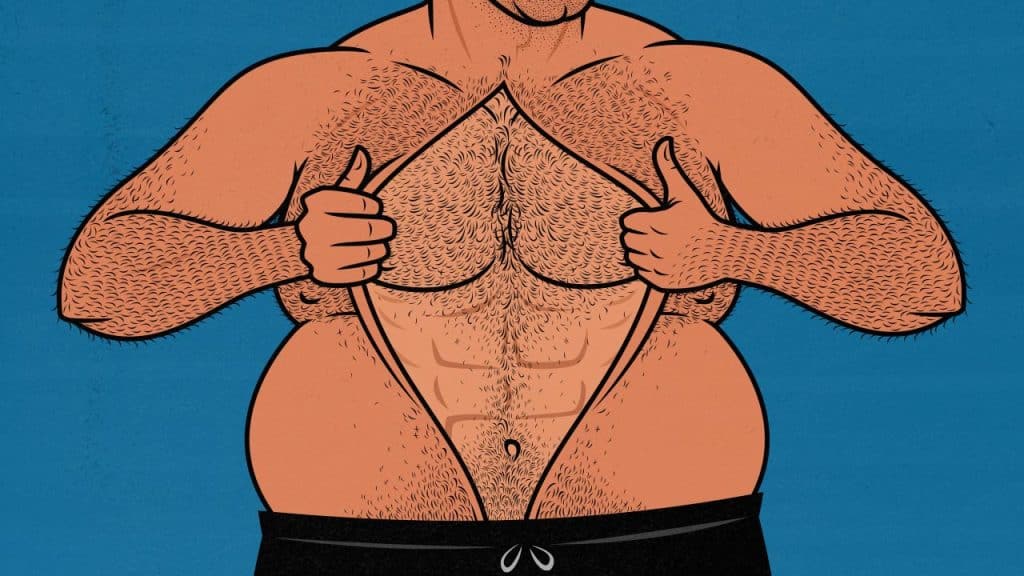
The Cutting Guide: How to Burn Fat While Building A Bit of Muscle
Cutting is when you burn fat while keeping your muscle. You may even be able to gain a bit of muscle while cutting, especially if you’re overweight, out of shape, or new to lifting weights.
- Bulking: eating excess energy to gain weight and facilitate muscle growth.
- Cutting: eating in an energy deficit to lose weight and facilitate fat loss.
Whether you’re bulking or cutting, the goal is to be strong, muscular, lean, and healthy. That means you need to focus on hypertrophy training, eating a good diet, getting enough sleep, being active, and living a healthy lifestyle. That will mitigate muscle loss, keep your bones and tendons strong, mobilize “stubborn” fat, and keep you healthy.
What sets cutting apart from bulking is that your primary goal is to lose fat. The best way to lose fat is to eat less energy than you’re burning, forcing your body to burn body fat to supply the missing energy. This is called a calorie deficit. Eating fewer calories is the easiest way to get into a calorie deficit, but you can also create a deficit by being active.
Let’s dive into the details.
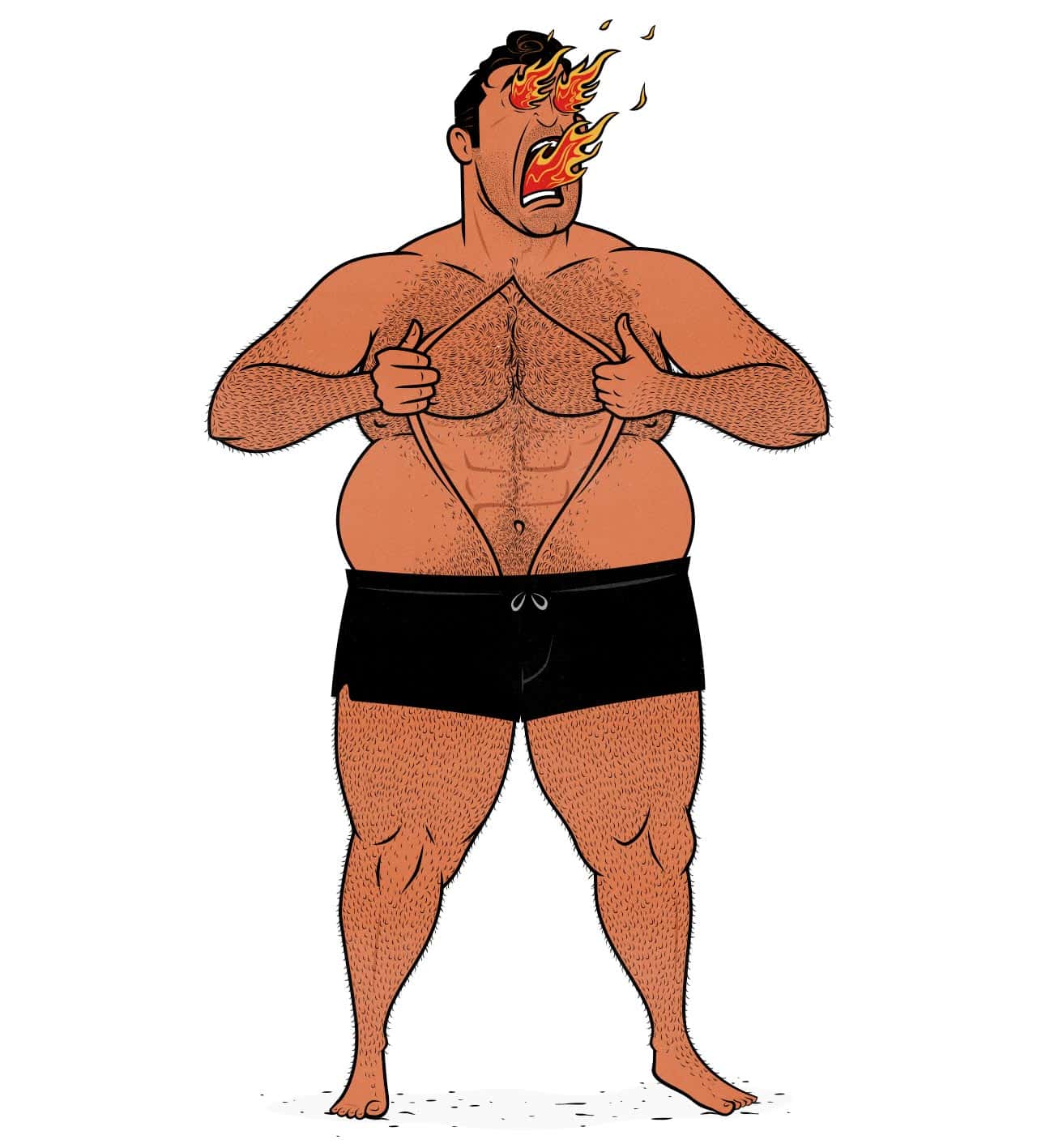
Should You Cut?
It’s normal to gain a little bit of fat while bulking. That doesn’t mean you’re doing anything wrong. Your body is investing some of the extra energy you’re eating into muscle growth and saving the rest for later, as body fat. That’s a responsible, healthy way for your body to manage those extra resources.
Think of your body fat like a bank account. Your calorie intake is your salary. Your body functions and activity levels are your expenses. When your salary is larger than your expenses, the wisest thing to do is set aside a few months of savings and then begin investing. Your body sets aside savings by storing body fat. It invests by building bigger muscles, stronger tendons, and denser bones.
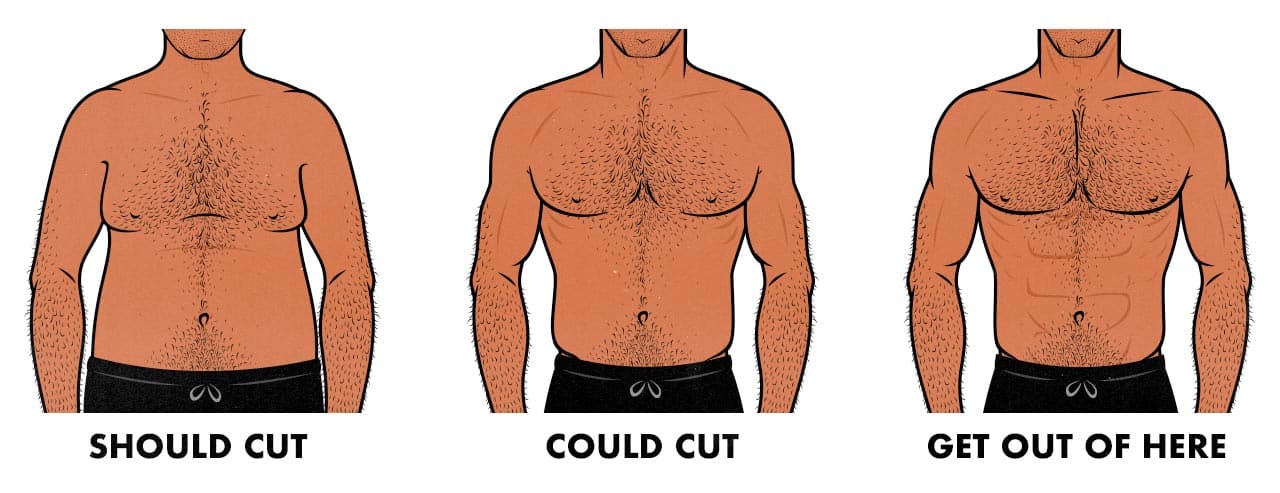
Body fat only becomes unhealthy in excess. Bulking from 10% body fat up to 20% body fat isn’t associated with poorer health outcomes. According to the National Institutes of Health (NIH), body fat only starts harming your health when your waist circumference creeps past forty inches. Some health organizations recommend capping your waist circumference at 37 inches just to be safe. If you’re leaner than that, there’s no reason to think you should cut. You may still want to, though. It can definitely look cooler to be leaner.
So, even if you gained some fat while bulking, that doesn’t necessarily mean you ought to cut. Some naturally thin guys won’t ever need to cut. Sometimes the extra fat melts away by itself once we stop bulking.
Here are some points to consider:
- Going from 10% body fat to 20% body fat probably won’t harm your health or appearance. It will hide some muscle definition, making you look less muscular with your shirt off, but it will also add some extra mass, making you look bigger with your shirt on. You’ll look buffer instead of leaner. That extra fat can be useful, too. You’ll have more weight to throw around, which can help with some lifts, contact sports, and martial arts (study).
- If your waist circumference is still well under 37 inches, you could go on another bulk instead of cutting. Our bodies tend to prioritize fat storage when we’re very lean. We evolved during a period when food was occasionally scarce, so our bodies consider it important to have some energy tucked away in savings. Once you have a sizeable savings account, though, your body may become less desperate to save body fat and more eager to invest in muscle growth. As a result, as you get deeper into your bulk, you may notice that you start gaining muscle more easily and leanly. If that’s happening, you may want to stick with what’s working. You may want to dive into another bulk. Just keep the calorie surplus modest. Maybe during this next bulk, you aim to gain 0.25–0.5 pounds per week instead of 0.5–1 pound per week.
- If you have a higher body fat percentage, you could do body recomposition instead of cutting. When you have a higher body fat percentage, your savings account is brimming with extra energy. It can use that energy to help you build more muscle even when you aren’t in a calorie surplus. If you eat according to your appetite, keep lifting weights, keep eating a good diet, and keep living a healthy lifestyle, you may slowly build muscle while gradually burning through your extra body fat. If you keep progressing in the gym without your weight on the scale changing very much, that’s a great sign you’re building muscle while losing fat.
- Many skinny guys naturally eat in a slight calorie deficit after they finish bulking, gradually settling back down to their “natural” body fat percentage. If you’re typically leaner than you are right now, you may slowly lose fat without needing to consciously cut. We call this “Reverse Bulking.”
But you might still want to cut. Maybe your waist circumference is creeping up to forty inches. Maybe you’re sick of being skinny-fat. Maybe you’ve got high blood pressure or some other health issue that can be resolved with a good cut. Maybe you hunger for muscle definition more than you hunger for food. Whatever your reason, cutting is an incredibly effective way to burn fat while keeping your muscle.
Okay, now let’s talk about how to cut.
How to Train While Cutting
Most people think of cutting as being mainly about diet. That’s not the case. If you start dieting before you start training, you’ll lose a mix of fat and muscle, getting smaller, but not necessarily improving your body composition, appearance, or health.
With a good training program, you can stimulate muscle growth, burn pure fat, maintain your strength, and keep your bones strong. Training will also help you burn proportionally more “stubborn” visceral fat, which is fantastic for your health and longevity.
Volume Vs Intensity While Cutting
There are a few different ideas about how we should train while cutting. Most bodybuilders argue for higher-rep, higher-volume training as a way of burning through more glycogen and calories, allowing you to burn more fat. A lesser-known advantage to that style of training is that it can build new blood vessels in the muscles you’re training, increasing their blood supply, and thus making it easier for you to build muscle when you go back to bulking (study, study, study).
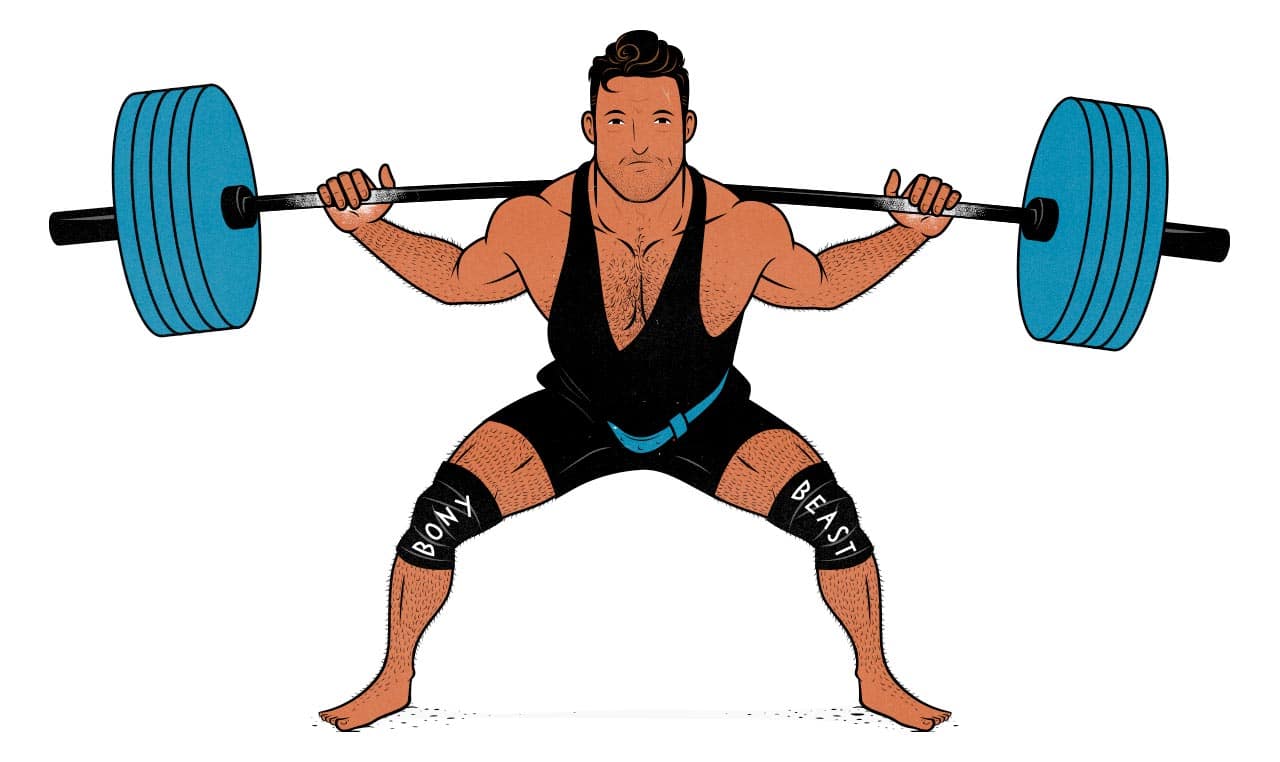
Most strength athletes argue we should lift heavier and do less work while cutting. Their reasoning is solid, too. Your muscles aren’t as packed full of glycogen when you’re cutting. You won’t have access to as much energy. It’s harder to do as many reps and sets. If you ration your effort into doing fewer but heavier sets, your performance stays higher, your strength peaks, you can set some new personal records, and you won’t feel as tired.
There’s no right answer here. Both styles of training stimulate more than enough muscle growth to preserve your muscle mass during a cut (study). You can use either approach. Even better, you can use a strategic mix of both. Maybe that means doing lower reps on your bigger lifts, striving for progressive overload, and higher reps on your smaller lifts, trying to build some new blood vessels. This tends to be the best way to train whether you’re bulking or cutting. May as well get the best of both worlds.
Overall, when you switch from bulking to cutting, your training doesn’t need to change very much, if at all. Just follow a good hypertrophy training program. If you’re already in the middle of a workout program, and if it’s working for you, then stick with it. If your training starts to wear you down, feel free to do fewer sets on the exercises that are tiring you out the most. (That often means doing fewer sets of deadlifts.)
Hypertrophy Training Principles
We’ve got full articles and entire programs about hypertrophy training. A good program will take care of all of this for you. Still, it’s nice to know what you’re doing and why you’re doing it. Here’s a bullet list of the most important factors:
- Challenge the strength of your muscles: the most important factor is to choose a style of training that allows you to challenge the strength of your muscles. If you’re limited by your balance, your coordination, or your cardiovascular system, that means you aren’t being limited by your muscles, and so they won’t have any impetus to grow bigger and stronger. This is just as true while cutting as while bulking. If you don’t stimulate muscle growth, your body will cannibalize your muscles for energy.
- Always strive for progressive overload: the best way to build muscle is to focus on getting stronger. Not like a powerlifter, where you’re solely focused on increasing your one-rep max on the squat, bench press, and deadlift. Rather, focus on getting stronger at a wide variety of lifts in a moderate rep range. Try to go from doing seven chin-ups to doing eight. Try to go from doing seventeen push-ups to doing eighteen. Try to add five pounds to your bench press for a set of ten repetitions. This is difficult while cutting. It’s okay if you don’t make much progress. It’s okay if you lose a bit of progress. Just try.
- Choose good exercises: build your routines on a foundation of compound lifts, such as goblet squats or front squats, push-ups or bench presses, Romanian deadlifts or conventional deadlifts, lateral raises or overhead presses, and pulldowns or chin-ups. After that, you can add in smaller lifts to work the muscles that aren’t being fully stimulated, such as lifts for your arms, neck muscles, and so on.
- Do enough reps per set: we tend to gain more muscle more easily when lifting in the 6–20 rep range, but anywhere from 4–40 reps can work fairly well. A good rule of thumb is to use lower rep ranges for your big compound lifts (4–10) and higher rep ranges for your lighter isolation lifts (8–30).
- Do enough sets per week: somewhere between 4–12 challenging sets per muscle per workout is ideal for building muscle. If you choose good exercises, train in the hypertrophy rep range, and lift hard, four is probably enough, especially if you’re training each muscle a few times per week. For your chest, that could be four sets of the bench press on Monday, four sets of push-ups on Wednesday, and four sets of an incline bench press on Friday. More is gravy.
- Train often enough: to maximize your rate of muscle growth, train your muscles 2–4 times per week. That could be three full-body workouts or a 4–6 day workout split.
- Get enough rest between sets: resting 2–5 minutes between sets will keep your performance high from set to set. To speed up your workouts, feel free to use supersets and the occasional drop set.
- Lift close enough to failure: you need to challenge your muscles to stimulate growth. You need to show your muscles they’d benefit from investing in becoming bigger and stronger. That usually means stopping 0–3 reps shy of failure, but sometimes going all the way to failure can be useful, especially with isolation exercises and back exercises.
Is it Normal to Lose Size & Strength?
It’s normal to lose a bit of strength, performance, and muscle size when cutting. Think of your muscles like balloons. When you bulk up, you add more rubber (contractile tissue) to the balloon while also inflating it with more air (glycogen). When you switch to a cut, you’ll lose some of that air. The balloon will deflate. And as it deflates, you’re losing fuel. Your muscles won’t be able to do as much for as long.
But you aren’t losing any of the rubber. When you start eating more food again, the balloon will inflate back up to a comfortable size. Bodybuilders and endurance athletes call this reinflation process “carb-loading,” but it happens naturally when you stop eating in a calorie deficit. When you reinflate your balloon, your performance will come right back.
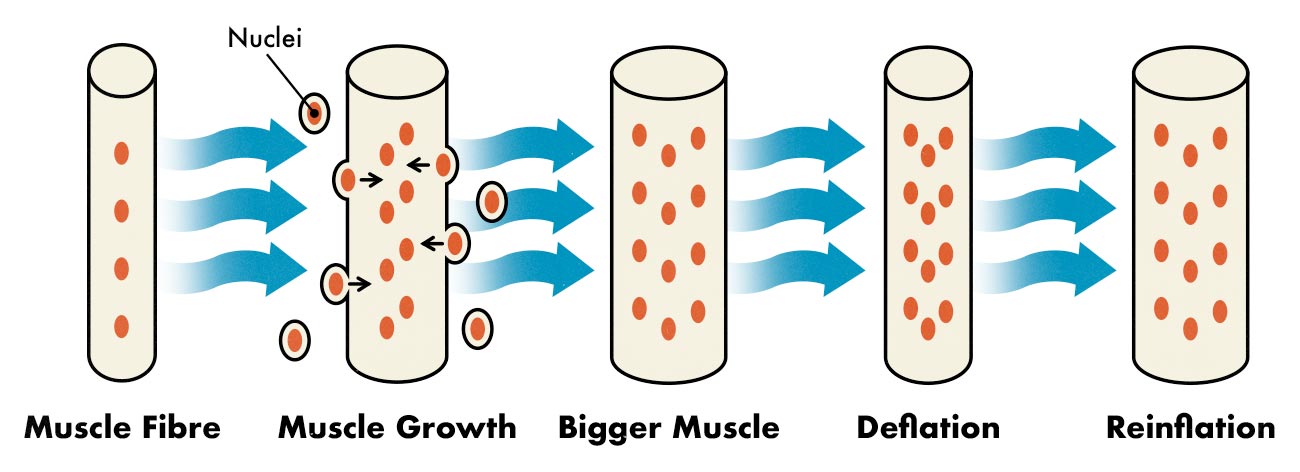
Also, keep in mind that some of the adaptations you make when building muscle are permanent. As you build muscle, your body will pull in more nuclei from surrounding cells. These nuclei make it easier to build and maintain bigger muscles. Once you add them to your muscle fibres, they’re yours to keep forever. Even if you lose a bit of muscle while cutting, your nuclei will stick around, making it much easier to regain that muscle in the future.
Don’t assume that you’ll lose muscle, either. If you have a substantial amount of fat to lose, and if your calorie deficit isn’t too severe, then you’ll still have plenty of energy to draw upon, even while cutting. Instead of losing strength, you may find that you’re able to progress somewhat normally, at least until you get so lean that your energy reserves dry up.
As you get deeper into your cut, keep trying to progressively overload your lifts. If you get stronger, great. If you don’t, that’s okay, too. As long as you cut properly, you’ll burn fat while maintaining virtually all of your actual contractile tissue.
The Importance of General Physical Activity
Being active is great while bulking. It’s just as good while cutting. Not only do you get all of the general health benefits, but you also get the added bonus of burning through a bunch of extra calories. It gets better, too.
One of the many benefits of exercise is that it helps us burn more “stubborn” visceral fat. This is important because visceral fat is the unhealthy type of fat. It’s the fat in and around our organs. We aren’t supposed to store fat there. If you have too much of it, it can cause problems.
You can get a pretty good idea of how much visceral fat you’re storing by measuring your waist circumference. As we mentioned earlier, The National Institutes of Health recommend a waist circumference of under forty inches. That’s rarely an issue for naturally skinny guys, but the average American male has a waist circumference of 40.5 inches (CDC). Getting under that threshold is a big accomplishment for most people.
The good news is that exercise helps to mobilize visceral fat. Any sort of exercise counts. Lifting weights helps. So does cardio. So does walking. And the effect holds true whether you’re in a calorie surplus or a calorie deficit. That means when you’re bulking, lifting weights will help you store less visceral fat. When you’re cutting, lifting weights will help you burn it. You can burn it even faster by being even more physically active.
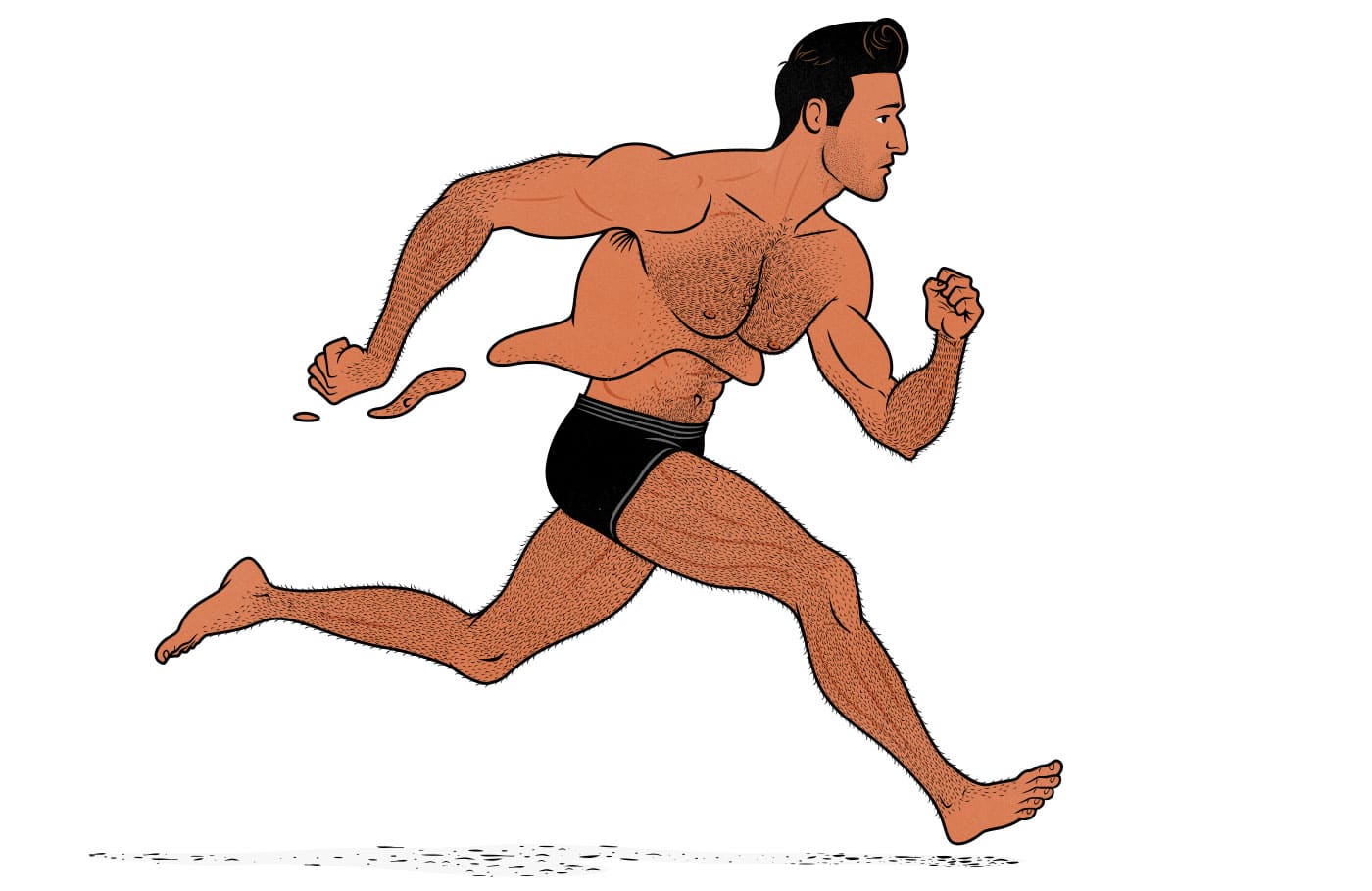
How to Do Cardio While Cutting
Walking is a great type of exercise to pair with lifting, especially when cutting. It isn’t difficult to muster up the energy to walk, you already know how to do it, it can improve your mood, and it can distract you from your hunger. Most bodybuilders try to burn stubborn fat by walking briskly on a treadmill, often with the treadmill set on an incline. They spend 30–60 minutes on the treadmill first thing every morning and then do their weight training in the afternoon. That can work very well. It will keep your hypertrophy workouts separated from your cardio workouts, preventing them from interfering with one another.
You don’t need a treadmill, either. You can go on a brisk walk outside, go on a bike ride, use a stationary bike, or do whatever sort of physical activity you prefer. This is also where activities like yoga, pilates, jogging, and pick-up games of basketball fit into a healthy lifestyle. You don’t need to do any one specific thing, you just need to build movement into your daily lifestyle.
Start with twenty minutes of physical activity three times per week and gradually work your way up to a full hour every day. If you’re tracking your steps with a pedometer, try to work up to at least 10,000 steps per day. If possible, try to keep that physical activity at least six hours away from your hypertrophy training. No big deal if you can’t.
How to Eat A Cutting Diet
How to Set Up Your Deficit
The only mandatory difference between a bulking diet and a cutting diet is your calorie intake. When you eat fewer calories than you burn, you need to make up for that deficit somehow. Your body can burn the sugar in your muscles and liver (glycogen), it can cannibalize your muscles, or it can burn body fat. If you’re following a good hypertrophy training program, your body will try to get all of the energy it needs from glycogen and body fat, not from muscle. That’s how you cut.
Just like with bulking, you can cut more aggressively or more cautiously:
- Aggressive cutting can be good if you’re obese or quite a bit more overweight than you usually are. Because there’s such an abundance of fat available, your body may feel fairly comfortable burning through it quite quickly. Aim for a calorie deficit of around 500–750 calories per day, losing around 1–1.5 pounds per week. If you don’t lose weight for two weeks in a row, reduce your calorie intake by another 200 calories. Keep weighing yourself and adjusting, just like when you’re bulking.
- Cautious cutting is good for people who are already healthfully lean. It’s also great for longer periods of steadier fat loss. You won’t feel as hungry, you’ll maintain more energy, and your workouts will be more productive. You may even gain muscle mass, especially if you’re skinny-fat, overweight, or out of shape. Set aside two or three five-week phases to give yourself enough time to lose a significant amount of fat. Aim for a calorie deficit of 250–500 calories per day, losing around 0.5–1 pound per week. If you lose less than 0.5 pounds for two weeks in a row, remove another 200 calories. Keep weighing yourself and adjusting, just like when you’re bulking.
You aren’t locked into either approach. You could start more aggressively and then slow things down as you get deeper into your cut. If you’re looking for a default, aim somewhere in the middle. Try to eat in a deficit of about 500 calories per day to lose around a pound per week on average. If you aren’t hungry, it’s okay to lose fat a little faster.
How Many Calories to Eat While Cutting
You don’t need to know your calorie intake to cut. A simple way to get into a consistent calorie deficit is to eat similar meals at similar times every day, eating a little bit less whenever your weight loss stalls. When you eat a consistent diet, it’s easy to eat a similar number of calories every day, and it’s easy to remove some of those calories when you stop losing weight. A steady meal schedule is also ideal for your appetite and digestive system. This is the approach I use.
Another great way to cut is to track your calories. I’ve tracked my calories in the past, and I’m thankful that I did. I learned a lot about the energy content of the foods I tend to eat, and I still benefit from that knowledge now, nearly ten years later.
If you decide to track your calories, we’re affiliated with MacroFactor. We tested all the different calorie-tracking apps, and it’s by far the best one for both bulking and cutting. They also adjusted it based on our feedback to be better for naturally skinny guys.
Tracking won’t necessarily improve your results, but it will give you a clearer idea of exactly how much you’re eating, and it will tell you exactly how to adjust your calorie intake based on the results you’re getting. You can combine their calorie recommendations with our programs without any issues. If you want to try out the app, you can use the code “b2b” to get an extended free trial.
We have a cutting calorie calculator here. The calculator uses the best formula for estimating calorie intake, but it’s still just an estimate. And even if that estimate is correct, it’s just a starting point. Your metabolism will adapt over time. The important thing is to weigh yourself every week and adjust your calorie intake. That’s how you coax the scale into obeying you. If you can do that, your results are guaranteed.
*It’s relatively normal to lose 1–4 pounds during your first week of cutting. You’re eating less food, there’s less food in your gut, and you’re holding onto less fluid. You don’t need to adjust anything yet.
**If you don’t lose ANY weight during the first week of your cut, you can trim another 200 calories out of your diet right away.
Ideal Protein Intake While Cutting
In this study, Longland and colleagues put the participants on a hypertrophy training program and told them to eat in a calorie deficit. Half of them ate a fairly average amount of protein (about 0.5 grams of protein per pound bodyweight per day), whereas the other half were instructed to eat a full gram of protein per pound bodyweight per day. For a 150-pound man, that’s the difference between eating 75 grams versus 150 grams of protein per day.
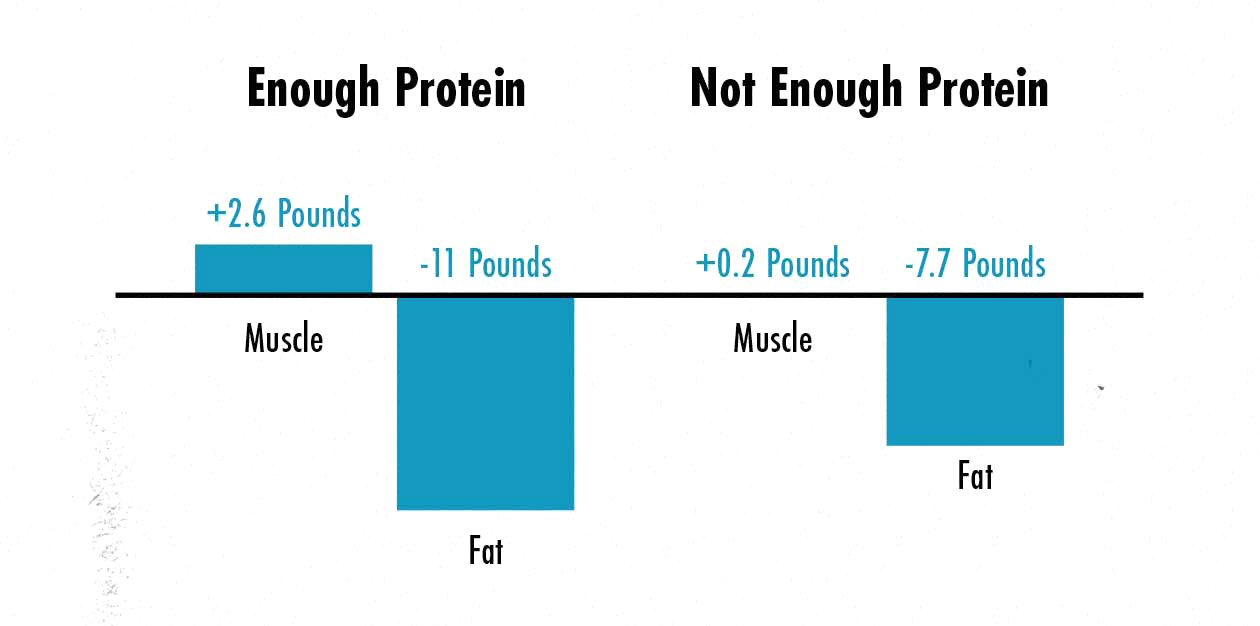
After four weeks, the participants who ate a normal amount of protein lost 7.7 pounds of fat and gained a negligible amount of muscle. Those are great results, and it shows you can don’t need a tremendous amount of protein to preserve your muscle mass while cutting. Hypertrophy training is incredibly powerful. It does a great job of preserving muscle mass all by itself. However, the participants who ate more protein lost 40% more fat while gaining nearly three pounds of muscle. That’s much better. It shows that the more factors you optimize, the more dramatic your results will be.
If you want a protein target to aim for, we recommend trying to eat a gram of protein per pound bodyweight per day. If you’re quite overweight, you could instead try to eat a gram of protein per pound goal body weight per day. So if you’re 200 pounds and trying to cut down to 170 pounds, you could aim for 170 grams of protein per day. Don’t panic if you fall short of that target, especially if you’re doing everything else correctly.
The Best Cutting Macros
You don’t need to eat specific macros while cutting. Ideally, you’d eat a balanced diet. You’d have some protein, carbs, fat, and plenty of fibre in every meal. You don’t need specific ratios, you just need to eat a nutritious diet that suits you. If you’re craving more fruit (carbs) instead of more nuts (fat), that’s totally fine. If you’re craving more cheese (fat) instead of more potatoes (carbs), that’s also fine. Your body knows how to tell you what categories of nutrients it wants.
You don’t need to track your macros. If you want to, though, then here are some minimum targets:
- Carbs: a good rule of thumb is to eat at least 3–4 grams of carbs per kilogram of body weight (1.4–1.8 grams per pound). If you weigh 180 pounds, that’s around 250 grams of carbs. About 1,000 calories. More is great if you have room for it.
- Fat: a man of about average height needs around 45 grams of fat per day. About 400 calories. More than that is often better if you can fit it into your diet.
If you’re eating very few calories, it can be harder to get the nutrients you need in your diet. That’s another reason why maintaining higher activity levels while cutting is so valuable. The higher your calorie intake is, the more flexible you can be with the food you eat.
The Best Cutting Diet
Whether you’re bulking, maintaining, or cutting, you want to eat a diet that supports muscle growth, is rich in nutrients, and keep your digestive system running strong. You can do that by eating a balanced diet made up of a variety of whole foods. When you gear into a cut, try to keep the quality of the food you’re eating high. The only thing you need to change is the amount of food you eat.
- Quality: whatever diet you follow, you should try to get most of your calories from minimally processed whole foods. Think of foods like fruits, vegetables, legumes, whole grains, nuts, seeds, seafood, lean meat, eggs, cheese, Greek yogurt, and dark chocolate. You can use plenty of spices, garlic, onions, and hot peppers. You can drink plenty of coffee and tea.
- Quantity: you need to eat in an energy deficit. When you’re in an energy deficit, your body will be forced to burn fat to make up for the missing energy. You can drive yourself into a deficit with exercise, but most people do best when they reduce the number of calories they’re eating, too. You need to eat enough protein to support muscle growth, so you probably want to remove calories elsewhere. For example, you could start by reducing your calories from junk food, deep-fried food, sugar, saturated fat, and refined grains. If you need to remove even more calories, remove more fats and carbs. Maybe that means swapping out bananas for broccoli, cutting down on carbs while keeping your intake of fibre and micronutrients just as high.
If you follow the evidence-based fitness community, it’s easy to become disillusioned with the name-brand diets. “Keto is bullshit because it unfairly demonizes carbs.” That kind of thing. And that’s true. Low-fat and low-carb diets tend to produce the same amount of fat loss on average (study). There’s no need to specifically restrict fat. The same can be said for breakfast, grains, fat, fruits, animal products, and all the other things name-brand diets tend to restrict. With that said, most popular diets have some sort of fat-loss trick up their sleeves.
When most people switch to a ketogenic diet, they find themselves naturally eating fewer calories, and so they start losing weight (meta-analysis). Same thing when people switch to intermittent fasting, low-fat diets, low-sugar diets, high-volume diets, clean diets, and plant-based diets (meta-analysis). Most of those diets aren’t very good for bulking, but almost all of them are viable while cutting. That’s why they’re so popular.
You don’t need to follow a named diet. You can reduce your calorie intake while continuing to eat a balanced diet with a regular meal schedule. I think that makes for a great default. It’s what I do. But most named diets are popular for a reason. It’s okay to experiment with them. Just make sure you aren’t falling victim to the hype. All of these diets work the same way: they make it easier to sustain a calorie deficit.
Here’s the real trick. Whatever diet you follow, the quality of your food should be high. Don’t fall into the trap of cutting out carbs and replacing them with keto cookies. Don’t skip breakfast and use it as an excuse to eat junk for dinner. Don’t avoid animal products and replace them with processed vegan cupcakes. You get the idea: no diet will save you from the curse of needing to eat healthy food to maintain your health.
Is It Normal to Feel Hungry While Cutting?
There’s this idea that fat-loss diets should be sustainable forever. You’ve probably heard that argument before. “Choose a diet that doesn’t feel like a diet.” There’s a fairly major flaw in that line of thinking.
When we’re bulking, there’s an abundance of energy. There’s no sense of need or danger. Our bodies feel happy to relax. It can be a bit of a bummer for our productivity at first, but as we get used to that steady influx of energy, our bodies begin spending it more freely, building bigger muscles and denser bones, and giving us more energy to do more things. Soon, we’re overflowing with vitality. We feel more vigorous and powerful and strong.
When we’re eating at maintenance, there’s balance. We aren’t overflowing with energy, and we aren’t growing bigger, but we aren’t lacking anything, either. Once again, there’s no sense of danger or vulnerability. We tend to feel satisfied after eating and hungry as our next meal approaches. It’s a natural way of living. It’s incredibly enjoyable and entirely sustainable.
Cutting is a different beast. When people first start experimenting with lower-calorie diets, such as low-carb diets, intermittent fasting, keto, or plant-based diets, they often get a flood of extra energy. It can feel fantastic. Euphoric, even. This happens because your body is ramping up stress hormones, such as cortisol, to give you the energy to go find some damn food before you starve. This isn’t good or bad, it’s just our evolved response to an energy shortage. (I try to take advantage of this by eating relatively little in the morning, when I’m trying to be my most productive, and less at night, when I’m trying to quiet those stress hormones and ease into a restful slumber.)
Those stress hormones are there to help you find food. If you fail at that, your body will turn up the hunger dial, giving you more motivation to find food. It will flood you with cravings. And not cravings for the food you normally eat, but deep yearnings for calorically dense foods you may not normally find appealing. You might want to eat spoonfuls of peanut butter or honey, crush an entire family-size bag of potato chips, and then eat an entire tub of ice cream. You might start adopting the classic hungry dad behaviour of finishing your family members’ plates. When your body has big deficits to make up for, it will go to great lengths to help you eat big. But you cannot eat big. You’re cutting.
This can result in weird behaviour. Your body is making you obsessed with food but you aren’t allowing yourself to eat, so that obsession can spill over into other “hobbies.” Maybe you start reading recipe books, watching cooking contests, or collecting limited-edition chocolate bars.
As your body gets used to a lower calorie intake, the extra energy may fade away. You haven’t succeeded in finding food, so your body may try to preserve your energy stores by becoming more austere—more ascetic. You’ll have less energy and be less inclined to move. It’s almost like hibernation. This is incredibly common among natural bodybuilders who are dieting down to under 10% body fat. This is how healthy bodies respond to severe and prolonged calorie deficits. This is when a cutting diet can start to become unhealthy. Your body stops spending the energy it needs to take care of your long-term health. This is one of the only unhealthy aspects of natural bodybuilding. Thankfully, I’m not a natural bodybuilder. You probably aren’t, either.
The point is, staying in a calorie deficit for several months in a row can be difficult. There’s a reason the majority of the modern world struggles with it. We skinny guys tend to have a genetic advantage, and I suspect your cut will go relatively smoothly, but that doesn’t mean it will be effortless—at least not forever. The faster you lose weight and the leaner you get, the more difficult it tends to become.
The good news is that cutting is temporary. When you finish your cut, you can go back to eating at maintenance. Maybe you’ll even switch to bulking. Either way, the calorie deficit will be gone, your hunger will fade away, and your diet will become sustainable again.
How to Manage Your Appetite
There are a few different ways to manage your appetite while cutting. Staying within a comfortable body-fat percentage range can help. If you’re naturally lean, maybe you stop your cut at 10–12% body fat. If you’re about average, maybe you stop your cut at 12–15% body fat. If you’re naturally fatter, anywhere under 20% is awesome.
You can prevent even more appetite issues by keeping your calorie deficit modest, losing somewhere in the neighbourhood of 0.5–1 pound per week.
Here are some more strategies for managing your appetite. Feel free to pick and choose:
- Protein can be filling. Eating a gram of protein per pound bodyweight per day will support muscle maintenance and growth, and it might also make it easier to eat in a calorie deficit. It isn’t the end of the world if you aren’t hitting this protein target, but if you can manage it, you might prefer it.
- Fibre is filling. Fibre only contains two calories per gram. That’s less than half as much as carbs and protein, and less than a quarter as much as fat. Fibre often tends to be harder to chew than the other macronutrients, too. Think of foods like beans, lentils, oats, other whole grains, corn, peas, strawberries, apples, other fruits, leafy greens, avocados, and basically every vegetable. Think of brown rice instead of white rice. Think of broccoli, cauliflower, and carrots. Think of salads and fruit salads with minimal dressing.
- Water is filling. Think of soups, broccoli, carrots, lettuce, celery, watermelon, and strawberries. Even potatoes can be quite filling if they’ve got enough water in them. Whole baked potatoes, yams, and sweet potatoes are great for this. You can also have non-caloric drinks. Start your day with coffee and tea. Have a glass of sparkling water along with every meal. Drink some sparkling water between meals, too. Have herbal (non-caffeinated) tea in the evening.
- Chewing is filling. Few foods are as filling as overcooked chicken breasts and lean cuts of steak. Chew your fruits and veggies instead of blending them into smoothies. Have Greek yogurt with frozen berries instead of a protein shake.
- Surround yourself with the right kinds of foods. If you have the option of getting rid of common temptations, do it. Calorie deficits bring cravings, and we all have different cravings. If the chips in the cupboard are calling out to you, give them to an enemy. Replace them with a better option that serves a similar function. Popcorn is a whole grain that’s rich in fibre, making it great for replacing chips, provided it isn’t loaded with extra sugar and fat. Some diet popcorn brands are pretty good. You can also pop your own and season it with paprika, sea salt, and nutritional yeast. If ice cream tempts you, replace it with Greek yogurt with frozen berries, which is quite filling, super nutritious, and delivers a full serving of protein. Fill your pantry, your cupboards, and your fridge with healthy foods that support your goals and satisfy your cravings.
- Meal prep is great while cutting, too. If you have ten servings of chili and another ten servings of homemade protein bars in the fridge, you’ve got easy access to both savoury and sweet meals that are great for you. During moments of temptation or laziness, all you need to do is reach into the fridge. Satisfying your cravings with healthy options becomes easier than ordering food or running to the corner for some churros.
- Sauces and spices are often free. Most hot sauces don’t have any calories in them. Neither do soy sauce, mustard, and vinegar. And you can use as much pepper, garlic, onions, herbs, and spices as you want. Some salt is fine, too.
- You don’t need to eat as often. Bulking is all about starting early, eating often, and finishing late. Cutting gives you more freedom. You’re welcome to eat more often if you prefer it, but if you aren’t hungry first thing in the morning, it’s okay to delay your first meal. If you aren’t hungry right before bed, there’s no need to eat after dinner. On the other hand, if skipping breakfast makes you binge in the evening, don’t skip breakfast. Or if you’re like me, and you find it easier to fall asleep after filling your stomach with some Greek yogurt and frozen berries, go for it.
- Beware of oils. Oils are incredibly calorically dense. As wonderfully nutritious as extra-virgin olive oil can be, you have to watch out not to overdo it. A single spoonful of oil contains around 120 calories. If you stop cooking with as much oil, you can trim tons of calories out of your meals. Instead of pan-frying, switch to roasting or using the barbecue. Maybe go for low-fat dairy and extra-lean cuts of meat, giving you more protein and fewer calories per serving. (I make an exception for fatty seafood, such as salmon. It has more calories than white fish, but the EPA and DHA are easily worth it.)
- Keep yourself busy. Being idle is often the hardest. Most people succumb to their cravings while watching TV. You could try to occupy your hands with something. Maybe you want to draw or knit. You could try reading or playing video games instead. If you have the energy for it, you could go for a walk. Maybe listen to a podcast or audiobook while you do it. Or maybe you really do want to sit on the couch and snack. In that case, maybe snack on carrots, low-calorie beef jerky, or popcorn (with no fat/sugar added).
- Avoid processed foods. I almost forgot to add this one. It probably goes without saying, but highly processed foods like potato chips, milk chocolate, donuts, cupcakes, ice cream, butter, and bacon all taste pretty good, aren’t very filling, and often cause people to eat too many calories. For your health, you should moderate your intake of these foods. When you’re cutting, you may want to cut back even further.
- Hunger and cravings are normal. The beginning of a cut is often relatively easy, especially if your body isn’t desperate to hold onto that extra fat. If you just finished bulking, your body definitely isn’t desperate to hold onto the extra fat. But as you get deeper into a cut, it’s totally normal to have issues with hunger and cravings even when you’re doing everything properly. This isn’t some sort of malfunction, it’s just your body correctly realizing you’re burning fat. You may need to get a bit comfortable with being a bit uncomfortable. It’s temporary.
With all of that said, we naturally thinner guys often have a fairly good time while cutting, especially when we’re losing weight relatively slowly and especially when we aren’t trying to get much leaner than we’re used to. You may find that your cut goes super smoothly and feels great the entire way through, even if you keep eating the foods you most enjoy eating. These strategies are here to help you when you need help. If you don’t need help, feel free to do your own thing.
How to Take Diet Breaks
You may have a week or a weekend where you’re off hiking or travelling or being active, you burn more calories than usual, and you fall behind on your calories. That’s fine if you manage to stick with your habit of lifting weights. In that case, the extra deficit will burn some extra fat. If you can’t keep lifting weights during those busier moments, you may want to take a break from cutting. That way, you don’t cannibalize your muscle. A good rule of thumb is to eat in maintenance if you haven’t lifted weights in the last four days.
If you ever want to take a planned break from your calorie deficit, that’s okay. Just make sure you aren’t giving into a weak moment. When you have a craving and decide to eat a family-sized bag of chips, that isn’t a diet break, that’s a broken diet.
Proper diet breaks need to be pre-planned. They’re something you set up the week before. The break isn’t characterized by chaos and gluttonous abundance, it’s just a period where you eat at maintenance instead of in a deficit. You aren’t moving backwards. You aren’t regaining fat. You just aren’t moving forwards anymore. It’s just a break.
How to Sleep While Cutting
Getting enough sleep will help you balance your stress hormones, giving you more energy when you need it, and then allowing you to recover and adapt afterwards. It improves your motivation and willpower, allowing you to better stick to your diet and workout routine. It improves your performance in the gym and makes the strain of lifting weights feel more enjoyable. It also speeds up fat loss while allowing for simultaneous muscle growth.
In this study, Jåbekk and colleagues put the participants on a hypertrophy training program for ten weeks. Half of them were given simple instructions about how to improve their sleep. They gained 30% more muscle:
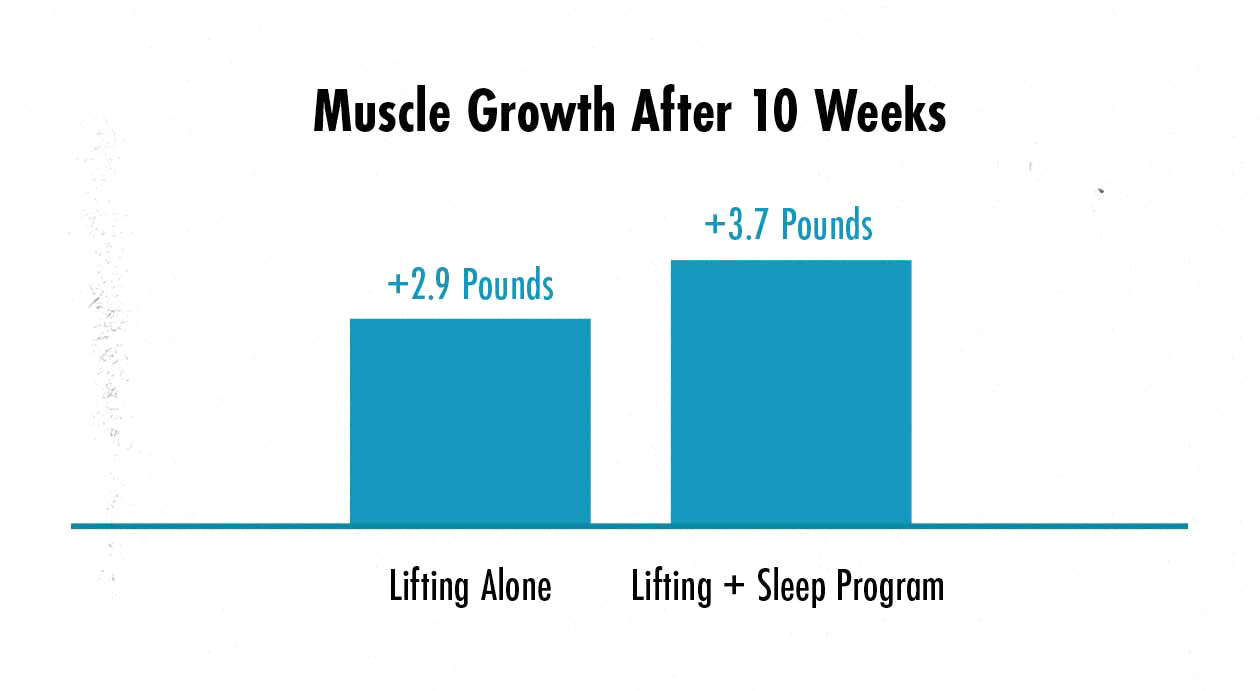
What’s even more interesting is the group who was only lifting weights tended to eat in a calorie surplus, allowing for muscle growth, but also causing a bit of fat storage. For every pound of muscle they gained, they gained around half a pound of fat. That’s not bad, actually. But the participants who were told how to improve their sleep did much better:
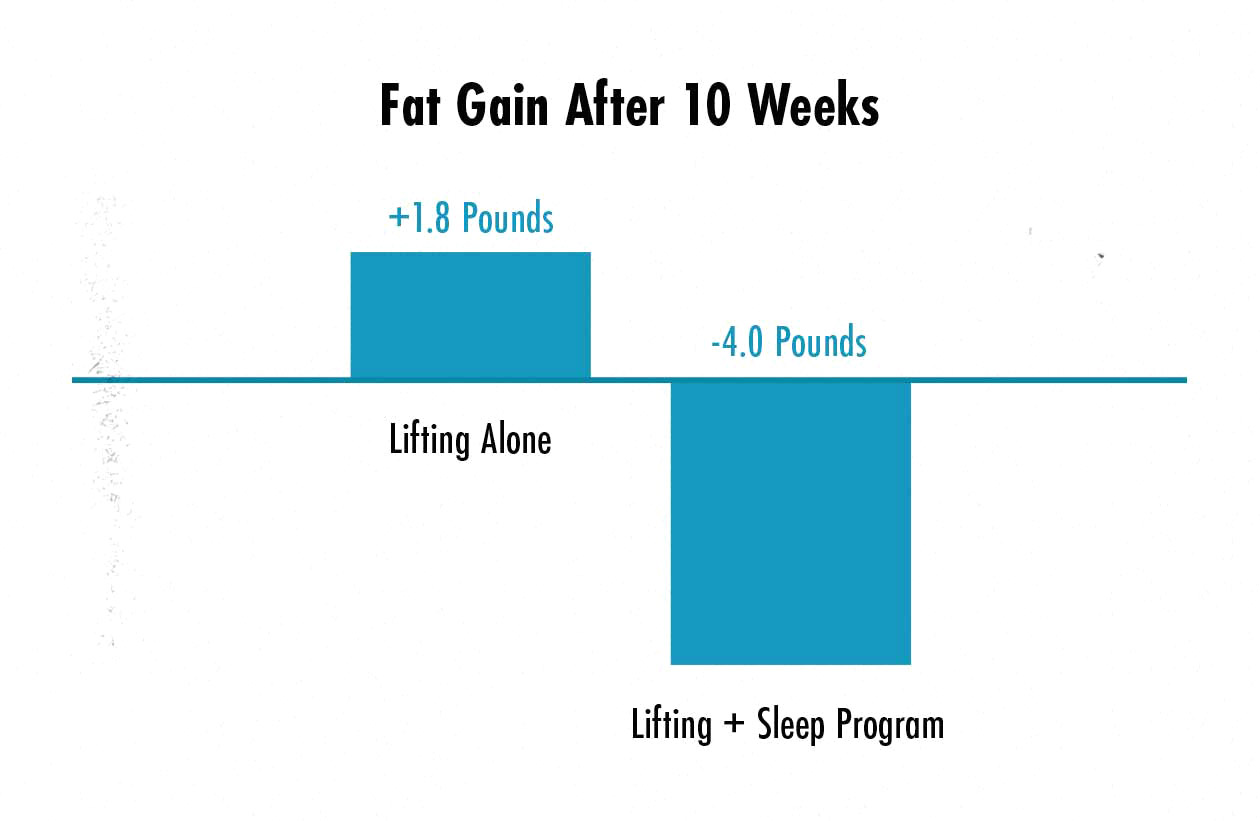
The people who got better sleep tended to eat in energy balance, neither gaining nor losing weight. This tends to make it harder to build muscle, but the extra sleep more than made up for that. They managed to gain four pounds of muscle while simultaneously losing four pounds of fat.
What’s nice about this study is you can reproduce the results. All the researchers did was give the participants a few tips about how to improve their sleep. We can give you those same tips, and if you implement them, you can get these same benefits. Let’s go over the most important ones:
- Go to bed on time. Most people need somewhere between 7–9 hours of sleep each night. As you adapt to a harder workout routine or a more active lifestyle, you may need more than you’re used to. Try to go to bed at least 8–9 hours before you need to wake up. If you wake up after 7–8 hours, that’s perfectly fine. The trick is to give your body enough time to get as much sleep as it wants.
- Build a bedtime routine that eases you into a restful slumber. There are myriad ways of gearing down for bed, and many of them are proven to work. You could dim the lights in your house in the hour or two leading up to your bedtime. You could switch from bluer lights to warmer ones. You could wear amber-tinted glasses to block the blue right from reaching your eyes. You could silence your phone, stop working, and stop checking notifications two hours before bed. You could also read in bed, distracting your mind from your daily stressors. The important thing is to develop a routine that helps you relax and fall asleep more easily. I’ve struggled with insomnia in the past and my son wakes me up pretty often in the night, so I use all of those tricks every evening.
- Keep your routine steady from day to day. Try to go to bed within thirty minutes of your bedtime every day of the week, whether it’s a weekday or a workday. That way your body will get into the habit of producing restful hormones in the evening and energizing hormones in the morning. You’ll feel sleepier before bed and have an easier time waking up.
- Avoid stimulants in the evening. That means cutting back on coffee and tea in the afternoon. It may also mean avoiding pre-workout drinks if you train in the late afternoon or evening.
- Avoid alcohol after dinner. Alcohol can make you feel sleepier, but it can also reduce the quality of your sleep, causing you to sleep less deeply and wake up more often. If you have a healthy relationship with alcohol, there’s nothing wrong with having a drink or two in the evening, even while cutting. Just try to finish your drinking before dinner. That way you’ve finished processing the alcohol well before you go to bed.
- Exercise. Hypertrophy training, general physical activity, and walking are all proven to improve the quality of your sleep.
For more, we have a full article on how to improve your sleep.
The Terror of Getting Smaller
There’s a strange phenomenon that happens while cutting. At first, it can seem like all you’re losing is size. You aren’t losing muscle or strength, but you also don’t appear to be losing fat. You don’t see any extra muscle definition. You’re just getting smaller. What’s going on here?
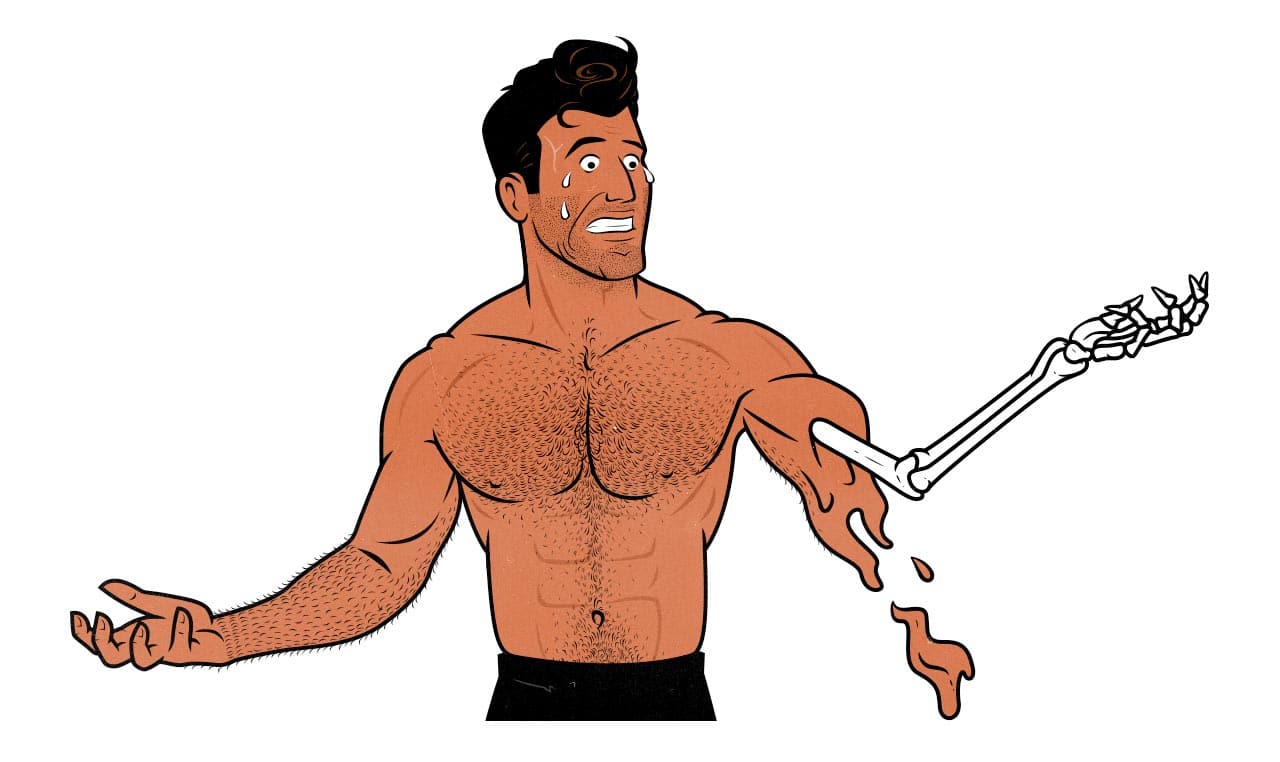
When most people begin a cut, they have a large fat layer covering their muscles. As they lose weight, this layer of fat gets thinner, which is great, but it won’t necessarily reveal any muscle definition until it gets very thin. This creates the illusion that you aren’t losing any fat, just getting smaller. But it’s just an illusion. That’s just how fat loss looks.
Your body is covered in these layers of fat. Some of them are thicker than others. Your body will burn fat in some places before it begins burning fat elsewhere. It’s possible to lose five pounds of fat in your legs or your lower back without really seeing any change in your arms or stomach (or vice versa). You may notice that your face gets leaner first, or last. You may even burn proportionally more visceral fat before you begin working on the subcutaneous fat, meaning that your waist will get smaller but you won’t see any increase in muscle definition. All of these things can happen, and all of these things are fine.
As you keep losing fat, you’ll eventually chisel out the areas you’re most excited about. You just have to be patient. You just have to keep going. Keep fighting to maintain and gain strength. Keep fighting to lose pounds on the scale. When you get under 20% body fat, you’ll look healthy. When you get under 15%, you’ll look athletic. When you get under 12%, you’ll look lean.
When to Stop Cutting
If you want to lose a significant amount of fat, I recommend setting aside 3–4 months. That’s enough time to lose a good 10–20 pounds at a reasonable pace. Some of that weight will be fluid and gut contents, but most of it will be fat. That should be enough for you to drop a good 5–10% body fat. Maybe more.
You don’t need to get that lean, especially if you’re planning on gearing back into another bulk. When you’re at a lower body-fat percentage than your body is comfortable with, it will sense that you’re vulnerable to starvation, and so it will prioritize regaining fat before it starts investing in building more muscle.
For example, you might spend two months losing five pounds, dropping 3% body fat, going from 12% down to 9%. And that’s great. Your abs will look much better. But when you switch back to bulking, you’ll spend your first month or two regaining those five pounds of fat, going from 9% body fat back up to 12%. That’s kind of a bummer. If you had stopped cutting at 12% body fat (or whatever your body-fat percentage naturally is) you could have avoided the frustration of losing and regaining those same five pounds of fat.
This stuff takes practice. You probably won’t know your “natural” body-fat range until you’ve gone through a few bulking, cutting, and maintenance periods. For me, getting under 11–12% body fat is a waste of time and effort. It will come back as soon as I start trying to get stronger again. I feel pretty lucky to be comfortable at such a low body-fat percentage. It’s not uncommon for naturally fatter people to have that same experience whenever they cut to under 20% body fat.
The point is that you should pay attention. Cut as lean as you like. Chisel out your abs if you want. But keep track of what happens. Pay attention to how things feel. After you finish cutting, does the hunger go away? Do you feel strong? Are you full of vigour and motivation? Being healthfully lean feels fantastic. Being overly lean doesn’t. And everyone is comfortable at a different degree of leanness. Maybe having abs feels fantastic. Maybe it doesn’t. You’ll have to feel it out.
What Results Can You Expect?
In this cutting study, Ackel-D’Elia and colleagues split the participants into three groups. The first group was put on a calorie deficit, the second group combined a calorie deficit with cardio, and the third group combined a calorie deficit with cardio and hypertrophy training. All of the groups succeeded in losing weight, with most of their weight loss coming from fat. The group that combined a calorie deficit, cardio, and hypertrophy training lost three times as much fat while gaining four pounds of muscle:
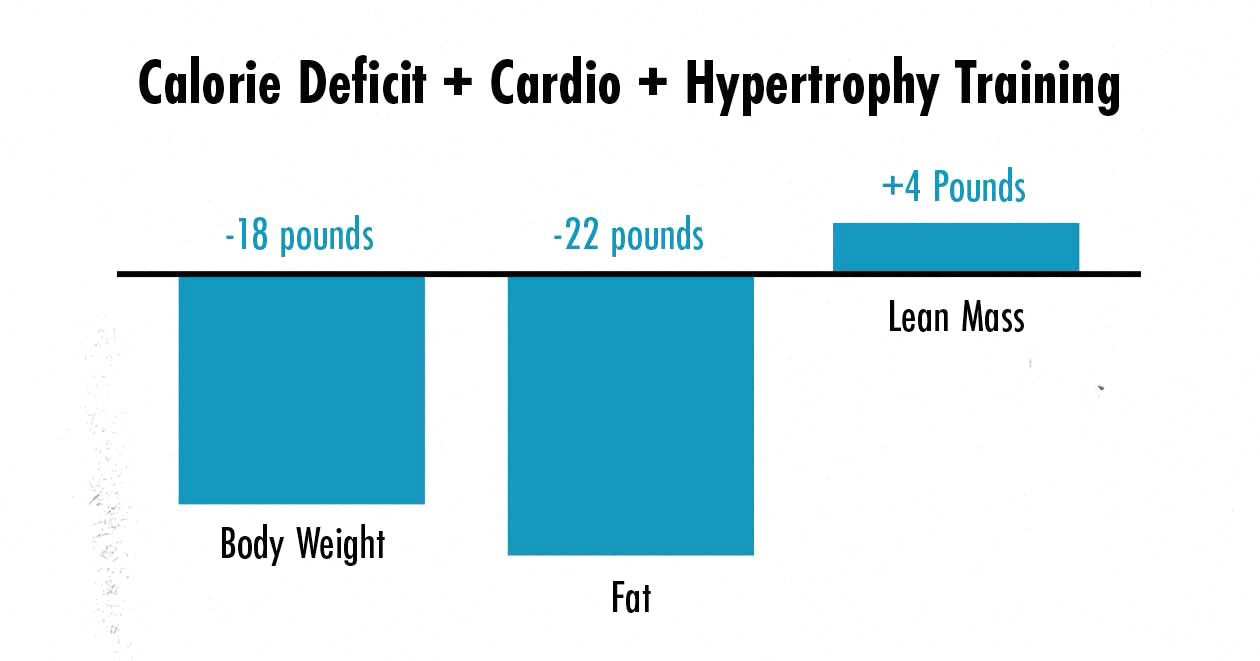
These results are incredible. One reason for that is these study participants were obese. If you’re starting off leaner than they were, you probably won’t be able to lose fat as quickly or build as much muscle while doing it (study). Still, it’s not unrealistic to lose fat and build muscle at the same time, especially if you’re out of shape.
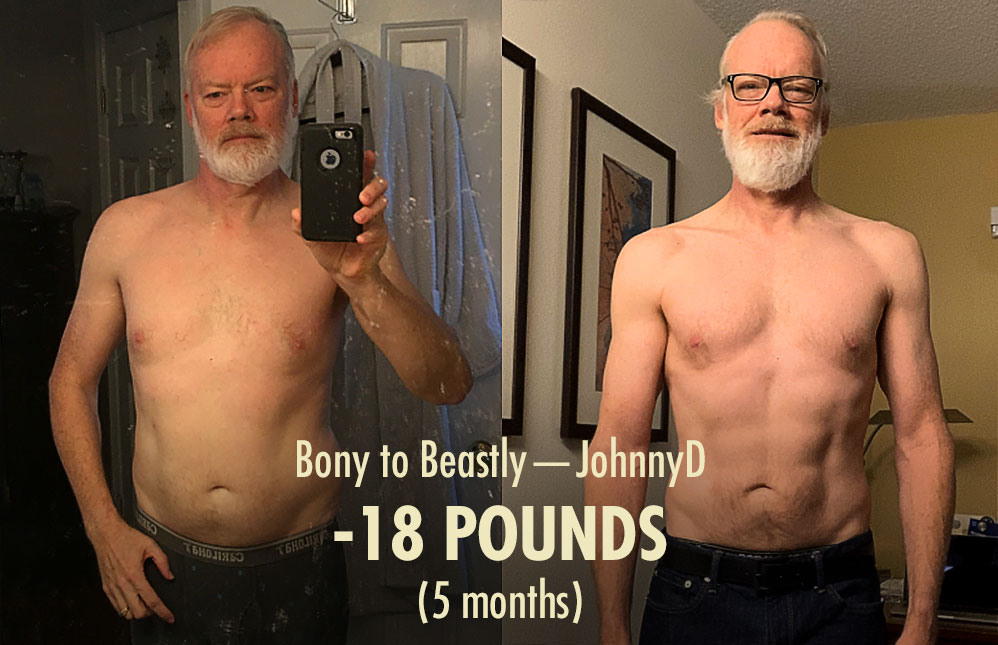
Hypertrophy training is incredibly powerful. If you pair with a calorie deficit, you’ll probably be happy with your cutting results. If you want even better results, you can add in an active lifestyle, adequate protein intake, a balanced diet, and good sleep. If you do all of that, you should be able to finish your cut even more muscular than when you started. If you’re already in great shape, or if you can’t quite do everything properly, maybe you’ll maintain your muscle mass instead of gaining more of it. If something goes wrong and you lose a bit of muscle, you can build it back quite quickly. Whatever happens, you’ve got this.
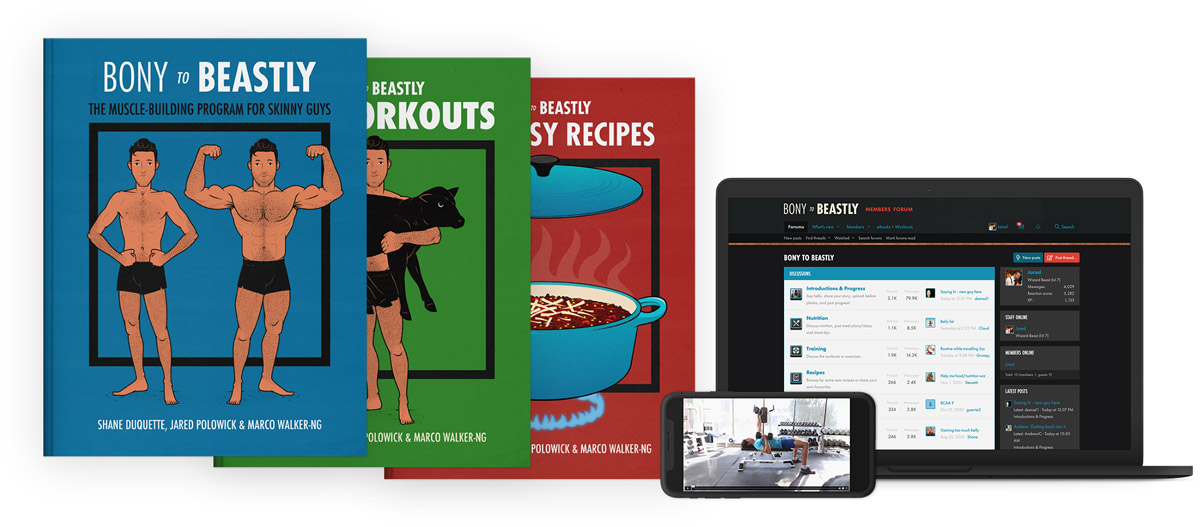
Alright, that’s it for now. If you want more muscle-building information, we have a free muscle-building newsletter. If you want a full workout and diet program, including a 5-month customizable full-body workout routine, a diet guide, a recipe book, and online coaching, check out our Bony to Beastly Program. It includes everything you need to know about how to build muscle and lose fat, including a full section on cutting. Or, if you want a customizable intermediate muscle-building program, check out our Outlift Program.
Shane Duquette is the founder of Outlift, Bony to Beastly, and Bony to Bombshell, each with millions of readers. He's a Certified Conditioning Coach (CCC), has gained 70 pounds, and has over a decade of experience helping more than 15,000 people build muscle. He also has a degree in fine arts, but those are inversely correlated with muscle growth.
